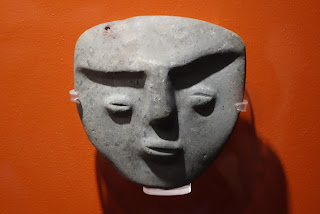Still catching up with Mexico photos...
On our third day visiting P in Mexico, we went to Teotihuacan.
We began just outside the perimeter of the site. Only about 10% of Teotihuacan has been excavated, so saying "just outside the perimeter" still means in the middle of the ancient city.
 |
| (source: http://www.frommers.com/images/destinations/maps/jpg-2006/41_teotihuacan.jpg) |
Our first stop was at the
palace of Tepantitla, where we admired the frescoes known as the "Paradise of Tlaloc"; P called them "Tlaloc's Water Park." Tlaloc was the Aztec god of water and agriculture.
 |
| Tlaloc, with his characteristic circular eyes. He's holding Tlaloc pots in his hands. |
 |
| Tlaloc's paradise? Or a mountain being fed with human sacrifices? |
The signage at Tepantitla says "as a whole, the scene represents an idyllic place of joy and happiness."
This website offers a bleaker interpretation: "But far from being a portrayal of paradise, the scene actually depicts the mountain being fed with humans. From the top of the mountain you can see a train of people falling inside, with their blood flowing down and transforming into the life giving waters." Indeed, some of the humans inside the mountain appear to be headless.
The paisley things coming out of people's mouths are thought to be speech bubbles, but no one knows what anyone was saying. Perhaps "whee!," "look Mom, no hands!," "get off that thing before someone gets hurt," and "prepare to feed Tlaloc's water-slide with your blood."
 |
| These folks had much to say, maybe about the fish, crabs, and butterflies |
The priests one wall over had more elaborate things to say.
Because I was not paying attention, or because the butterflies, crabs, and gamboling humans were so engrossing, I completely neglected to photograph the fresco of the
Great Goddess of Teotihuacan just above Tlaloc's water park. Here's an image of a reconstruction located at the National Museum of Anthropology:
.jpg/1280px-Great_Goddess_of_Teotihuacan_(T_Aleto).jpg) |
| By Thomas Aleto from Riverside, PA - Tepantitla Mural, CC BY 2.0, https://commons.wikimedia.org/w/index.php?curid=2781356 |
Our next stop was the museum, just inside the east entrance. Too many things to take photos of, so here are some things to do with clay:
 |
| Press molds! |
From the museum, we walked to the Temple of the Sun. Although the pyramid is not as steep as those in Egypt, the steps are tall and shallow. It's relatively easy climbing up, but difficult climbing down--especially for the acrophobe, who prefers to see what's below before stepping off each narrow ledge.
 |
| Temple of the Sun |
 |
| E looking for P down below |
 |
| Looking north toward the Temple of the Moon |
 |
| E and P, waiting. E virtually flew down the stairs. S held my hand and coaxed me down without ever making fun of me. |
From the Temple of the Sun, we headed south toward excavated residences. Rather than building up, the Aztec's filled in and built over. A few layers have been excavated and can be seen from the present-day ground; P says they go down as many as seven layers.
From there, it was on to the
Temple of the Feathered Serpent, also called the Temple of Quetzalcoatl.
 |
| The Temple of Quetzalcoatl, viewed from the Temple of the Sun |
 |
| Tlaloc |
 |
| Feathered serpent. These look like lions to me... |
After a few hours, we had only covered about half of the site. With places to go and things to do, we finished off by visiting two compounds outside the main archaeological site: Tetitla and Atetelco. At Tetitla, P enthusiastically showed us the frescoes of "priests with painted fingernails." Surfing the interwebs, one finds numerous photos of these priests--but shown just one at a time rather than in a pair. They're generally described as representations of the
Great Goddess of Teotihuacan--but comparing these to the photo of the National Museum of Anthropology reconstruction of the Goddess fresco from Tepantitla, one sees that
that goddess just has the eagle head, without the big-eared human heads underneath. Plus P knows who's who and what's what at Teotihuacan. With that said, here are the
priests with painted fingernails:
.jpg/1280px-Great_Goddess_of_Teotihuacan_(T_Aleto).jpg) |
| Here's the reconstructed goddess again, for comparison's sake. The guys to the right and left are priests. |
We drove in to San Martin Teotihuacan for lunch at the market: freshly squeezed juices and freshly made quesadillas, some stuffed with squash blossoms and some with mushrooms. Afterward, grocery shopping and back to Mexico City.










































.jpg/1280px-Great_Goddess_of_Teotihuacan_(T_Aleto).jpg)




























